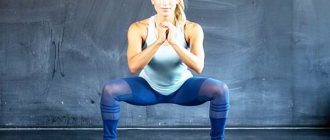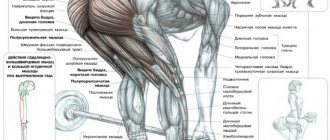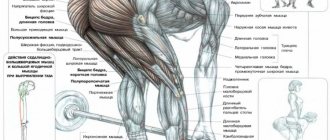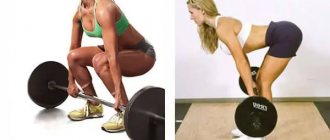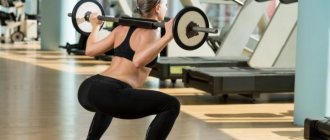Benefits and disadvantages of Bulgarian squats
An obvious advantage of split lunges is that this type of exercise is physically and technically difficult. Firstly, due to the elevation of the auxiliary leg, you need to maintain balance, and secondly, due to the lack of help from additional muscles. In this position, the athlete is deprived of the opportunity to help with the second leg.
This type of lunge uses the maximum number of muscles, compared to other lunge options, due to the position of the second leg, making it impossible to distribute the load.
The disadvantage of the exercise can be considered the technical difficulty of execution. Finding a comfortable position to perform the movement and maintaining balance is extremely difficult, which can lead to falls and injuries.
A person may also experience discomfort in the ligaments. People with ankle or foot injuries may find it impossible to perform this exercise due to severe discomfort or pain in the ligaments.
Benefit
This exercise primarily targets the quadriceps and glutes. Its best property is the ability to balance the leg muscles and make them equal in strength.
“By putting someone in a single-leg position, we can immediately identify weaknesses and strengths much more easily than with symmetrical squats or bench presses,” says Murrieta.
Bulgarian squats are a great way to take your leg and lower torso workout to the next level. This exercise targets the same muscle groups as traditional squats or lunges - quads, glutes, calves, abdominals and back muscles - but most of the work goes to the quads and core muscles because you need to balance while working with one leg.
Any time you train one side of the body, doing most of the work on one side of the body without the other, you have the opportunity to correct imbalances in muscle development. By removing these imbalances, you eliminate leaning to one side while performing other exercises. This way you will avoid many injuries and troubles in the future.
Also, by improving your balance with compound lower body movements, you will improve both overall mobility and core strength. This will make it easier for you to perform exercises that require good balance. For many young people, balancing is not a problem, but for older people, both loss of balance and the consequences of a fall, such as a broken leg or hand, will be a problem.
What muscles work in Bulgarian split squats?
When performing Bulgarian lunges, the following muscles are involved:
- Quadriceps.
- Gluteal muscles.
- Thigh biceps.
- Adductor muscles.
The stabilizing muscles are the spinal extensors and abdominal muscles.
Bulgarian lunge technique with dumbbells
- Stand at a short distance with your back from the bench, take dumbbells in your hands.
- Place one leg back on a hill, the knee of the back leg should not be straight.
- The supporting foot should be under the knee. Hands with dumbbells are freely lowered along the sides of the body.
- As you inhale, the pelvis goes down, the knees bend. The knee of the supporting leg should not extend forward beyond the toe.
- Exhale and straighten your supporting leg.
- At the end of the set, remove the foot of the back leg from the hill and change position to the other side.
Common mistakes
Bulgarian lunges are an effective exercise for shaping the shape of your legs. The technique of performing it has its own characteristics, which are associated with the need for careful coordination of movements and maintaining balance during squats.
Having studied the typical mistakes during lunges, you will be able to track them and hone the exercise technique to perfection. So, the main mistakes and ways to eliminate them.
| Errors | How to fix the error? |
| Distortion of posture during squats | Watch your back, keep your posture straight |
| The toe of the supporting leg is turned outward. | Turn the toe of the supporting leg inward |
| Step too short or too long | Calculate the optimal step length, which will prevent you from losing balance during a squat |
| Knee angle too sharp when lunging | When squatting, watch your knee |
| Do not complete squats | Squat until your supporting thigh is parallel to the floor (or lower) |
| Support your knee while coming out of a squat | Don't lock your knee while rising from a squat |
| Lean forward and move your knee forward during the exercise | Watch your knee, do not allow it to go beyond the plane of your toes. |
| Do jerk squats | Do the exercise slowly |
Read also: Deadlift
Initially, you need to develop the correct technique for performing the exercise and learn how to maintain balance while squatting. As you progress, you can begin to complicate the Bulgarian squats by using light weight dumbbells as weights. You can also choose a higher bench to make your squats as deep as possible. The optimal number of repetitions on one leg is 10-12 times. There are 3-4 approaches in a set.
Bulgarian lunge technique in Smith
Bulgarian lunges in the Smith machine allow you to focus on one or another muscle group.
- To train the front of the thigh, the foot should be placed strictly under the bar. Moreover, the load will be focused directly on the teardrop-shaped bundle of the quadriceps. The elevation for the auxiliary leg should be installed approximately half a meter from the machine.
- To effectively work the gluteal muscles, the front (working) leg should be placed as far as possible, and the bench closer to the bar. This way the amplitude of movement will be much shorter, the distance between the legs will also be shorter, but this will create a maximum load on the gluteal muscles, they will be in tension all the time. Naturally, when performing this exercise you will not be able to maintain your posture, since you will have to shift your body towards the bar.
Should you perform Bulgarian lunges in Smith in such a way that the knee angle is too sharp and the body is tilted?
Of course, this is not the best option for training legs. There are many more excellent machines and exercises in the gym, thanks to which the athlete will simply achieve results in the development of leg muscles.
Read more about leg exercises in the gym → Leg exercises in the gym for girls →
Execution technique
Initial position
- The barbell is placed on racks at approximately the height of the athlete's collarbones or slightly lower. It is better to place the apparatus lower if it is not possible to place it accurately, but not higher, because in this case there will be a risk of injury when completing the exercise;
- The stand is located at the back at a distance of an outstretched leg, so that it is convenient to place the supporting foot;
- The bar is located on the lower part of the trapezius muscle, the back is tense, the shoulders are brought to the center;
- The shoulder blades descend towards the pelvis along the spine;
- By straightening the legs at the knee joints, the barbell is removed from the racks;
- The athlete steps back and takes the starting position for a standard squat first;
- Then he brings the supporting leg to the platform and fixes it there;
- Stabilizes the spine, performs a slight forward bend if emphasis on the buttocks is required, or fixes the back vertically if not required;
- Aligns the pelvis so that the plane passing through the pelvic bones remains parallel to the floor.
Movement
- While inhaling, you need to bend the hip and knee joints and lower to an accessible depth;
- While inhaling, straighten up and return to the starting position;
- The required number of repetitions is performed on both legs, then the barbell is returned to the racks.
Bulgarian lunges with barbell
Attention
Even with an emphasis on the buttocks, there should be a moderate forward bend;
- Too much tilt spoils the exercise technique;
- The knee should not move forward too far. Weight is evenly distributed between the knee, ankle and hip joints.
Barbell Split Squat Technique
- Take a position in front of a bench with a barbell on your shoulders, with your back to it.
- The height of a bench or other elevation should not be much lower than the knee.
- The supporting leg should be placed on the bench.
- When performing the exercise, the athlete must monitor his posture. The back should be in a vertical position.
- The movement begins with a squat. The back leg is only used to maintain balance.
- The athlete will reach the lowest point of amplitude at the moment when the knee joint forms an angle of ninety degrees. During the downward movement, inhale. The movement is performed slowly and smoothly.
- When moving up, exhale. There is no need to fully extend the knee at the top of the movement.
Practical tips and advice
Recommendations (technical) for the implementation of the proposed complex:
- perform movements at a slow pace;
- keep your back straight, don’t bend over, look forward and not down;
- maintain an average stride length, without shortening or lengthening;
- Keep the supporting thigh parallel to the floor when lunging;
- do not sharpen the angle of the knee, do not point your toes forward, do not block it when lifting;
- start lifting by pushing off with your heel;
- follow the principle “from simple to complex”: gradually increase the number of repetitions, the weight of dumbbells and the height of the bench.
At first, it is important to maintain balance and then increase the depth of the lunges. When performing lunges with dumbbells, the arm muscles are also given a workout.
If your knee extends beyond your toes when squatting, you should move your leg forward a little further. To achieve maximum results, do not fully extend your knee when lifting; this will increase muscle tension. When squatting, the lower leg must be supported vertically.
If you follow the technique and recommendations, the results will be noticeable after two weeks of systematic training. Moreover, the result can not only be assessed visually, but also physically felt. When implementing the program, the efforts that were evident at the beginning will no longer be needed.

